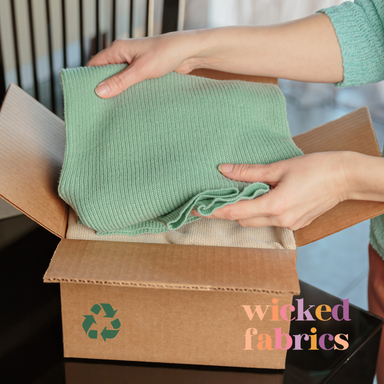Posted by Wicked Fabrics - Vivi Richards on 17th May 2024
Creating a Sustainable Sewing Practice
Read Time: 4m
As a sewist, you have a unique opportunity to contribute to sustainable fashion practices. With fast fashion becoming more and more prevalent, it's essential to make conscious choices about the materials, techniques, and patterns we use. In this blog post, let's explore seven strategies for creating a sustainable sewing practice that not only benefits the environment but also produces high-quality garments that will last for years to come.
Choose Sustainable Materials
The first step in creating a sustainable sewing practice is to choose sustainable materials. Look for fabrics made from organic or recycled fibres, and avoid synthetic materials like polyester and acrylic, which are made from non-renewable resources and take hundreds of years (if not thousands) to decompose. Additionally, consider using vintage or second-hand fabrics, which not only reduce waste but also add unique character to your projects.
When choosing thread, opt for natural fibres like cotton, silk, or wool, which will decompose more easily than synthetic alternatives. And don't forget about the packaging - try to choose materials that come in recyclable packaging or buy in bulk to reduce waste.
Finally, consider the environmental impact of the dyes and chemicals you use. Natural dyes like indigo, turmeric, and beetroot are a great alternative to synthetic dyes, which can pollute water sources and harm wildlife.
Reduce Waste
Sewing can produce a lot of waste, from leftover fabric scraps to discarded thread and broken needles. One way to reduce waste is to plan your projects carefully and buy the materials you need. Consider using pattern-making software to optimise your fabric usage and reduce the number of scraps you generate.
When you do generate waste, try to repurpose or recycle it. Fabric scraps can be used for patchwork, quilting, or even stuffing for pillows and toys.
Finally, consider investing in a compost bin for natural fibres like cotton and silk. These materials will decompose and provide valuable nutrients for your garden.
Choose Timeless Styles
Fast fashion is characterised by its trendiness and short lifespan. By choosing timeless styles, you can create garments that will last for years and reduce the need for constant replacement. Classic silhouettes like the A-line skirt, t-shirts, and cardigans never go out of style and can be easily customised to suit your personal style.
Additionally, consider choosing patterns with multiple variations to maximise their usefulness. A dress pattern that can be made as a maxi, midi, or mini can be worn year-round and in a variety of settings.
Finally, think about the versatility of the fabrics you choose. A neutral-coloured linen can be used for a summer dress, a pair of pants, or a lightweight jacket, while a bold print may be more limited in its usage.
Use Quality Techniques
The techniques you use can have a significant impact on the longevity of your garments. Opt for quality techniques you can achieve via your sewing machine or overlocker which will not only produce a more polished final product but also ensure that seams and edges do not fray or unravel over time.
Additionally, consider investing in high-quality tools like scissors, pins, and rotary cutters, which will make your sewing process more efficient and produce cleaner cuts and lines.
Finally, take care when pressing your garments. Use a pressing cloth to protect delicate fabrics, and avoid pressing too hard or for too long, which can damage fibres and cause permanent creases.
Repair and Upcycle
One of the easiest ways to reduce waste and extend the life of your garments is to repair and upcycle them. Learn basic mending techniques like darning and patching to fix small tears and holes, and consider upcycling old garments into new ones.
For example, a pair of worn-out jeans can be turned into shorts, a denim skirt, or even a bag. A bunch of too-small sweater can be repurposed into a "new" upcycled sweater! The possibilities are endless, and upcycling allows you to breathe new life into old favourites.
Choose Sustainable Sewing Machines
When choosing a sewing machine, consider the environmental impact of your choice. Look for machines that are energy-efficient and made from sustainable materials. Some brands offer refurbished or second-hand machines, which not only reduce waste but also save you money.
Additionally, consider the features you need versus those you want. A machine with too many bells and whistles may be more appealing, but it may also consume more energy and produce more waste.
Share Your Skills
One of the most sustainable things you can do as a sewer is to share your skills with others. Teach friends and family members how to sew, or consider volunteering at a local community centre or school. By spreading the knowledge of sustainable sewing practices, you can help reduce waste and promote conscious fashion choices.
Shop Sustainably
Finally, consider the environmental impact of the materials you buy outside of the sewing room. Look for brands that prioritise sustainability and ethical practices, and avoid buying from companies that contribute to fast fashion and waste.
Additionally, consider shopping second-hand or vintage for pieces you can recycle and sew into something wonderful. These pieces are not only unique and often high-quality, but they also reduce waste and promote conscious consumption.
By implementing these strategies, you can create a sustainable sewing practice that not only benefits the environment but also produces high-quality, long-lasting garments. Remember to choose sustainable materials, reduce waste, choose timeless styles, use quality techniques, repair and upcycle, choose sustainable sewing machines, share your skills, and shop sustainably. Together, we can create a more conscious and sustainable fashion industry!



